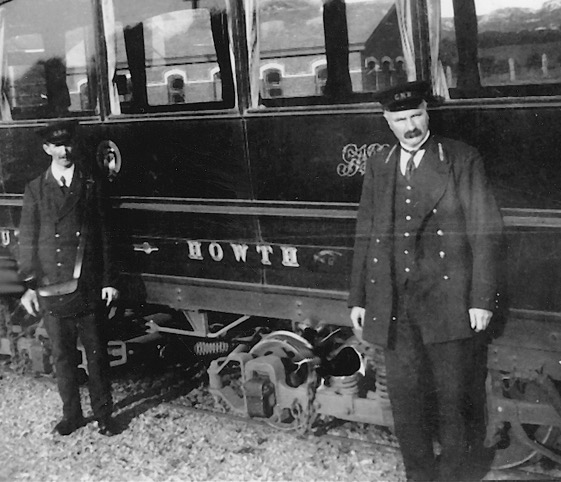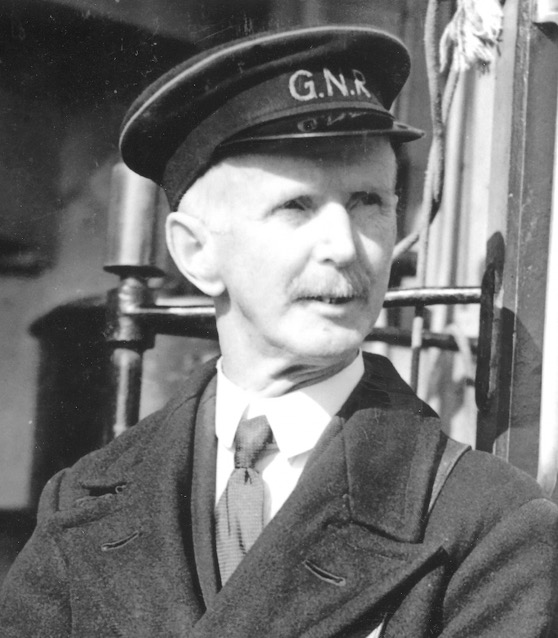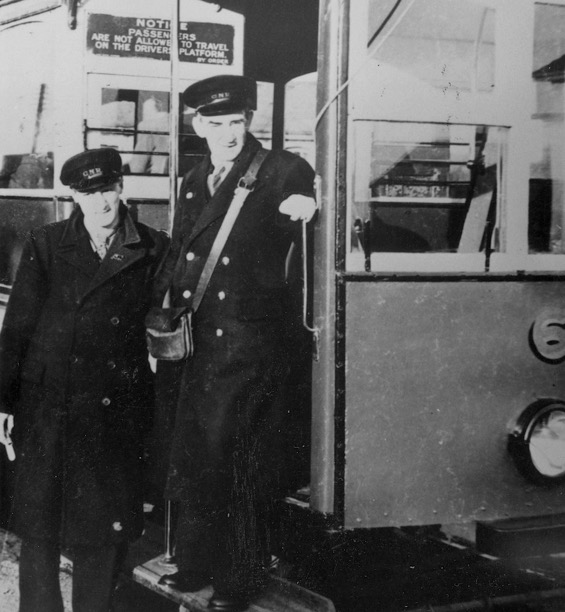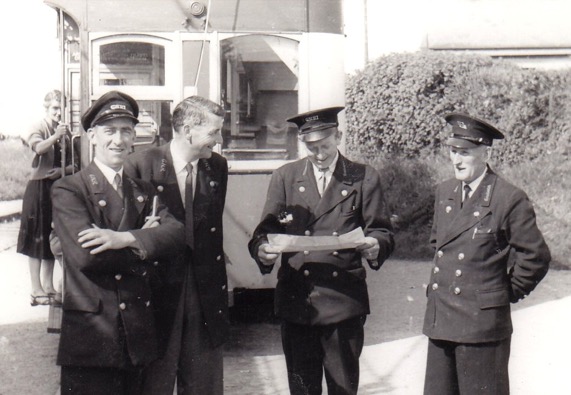Hill of Howth Tramway
History
The Hill of Howth Tramway was one of only a handful of tramways in the British Isles which was owned and operated by a railway company, in this case the Great Northern Railway Company of Ireland (GNRI). The GNRI already operated railway services to Howth, its predecessor, the Dublin and Drogheda Railway Company, having reached there on the 30th May 1847, almost half a century before a tramway up the hill was first mooted.
Prior to the building of the Hill of Howth Tramway, various proposals were made for a tramway between the Dublin United Tramways Company's terminus at Dollymount, and Howth, though nothing concrete happened until 1894 when a group of promoters calling themselves the Clontarf and Hill of Howth Tramways Company gained provisional approval to build a tramway between these two points, as well as an extension from Howth to the summit of the hill. The scheme was, however, ultimately dependent on the DUTCo for electricity, and the latter, with which the Clontarf promoters were closely associated, was in no position to provide it, as it had yet to apply for powers to convert its own horse tramway system, let alone generate electricity. The Clontarf scheme was therefore placed in abeyance until the DUTCo acquired powers to convert its lines outside the city boundary, including that to Dollymount, these not being granted until the 7th August 1896 under the Dublin United Tramways Act, 1896.
Meanwhile, the Clontarf scheme seems to have prompted the GNRI to consider obtaining its own powers for a tramway to the Hill of Howth, the railway company presumably not being enamoured of the prospect of having its passenger traffic extracted by a competing electric tramway.
The two applications now proceeded in parallel, the GNRI scoring a notable victory over its competitor on the 23rd December 1896, when it managed to successfully object to the Clontarf promoters' entire application on the grounds that the Privy Council had no authority to grant an order for a tramway between two places already connected by a railway, i.e., Sutton and Howth. The Clontarf promoters tried once again to gain approval, in 1897, this time using a different route, but this met with the same outcome.
Meanwhile, the GNRI successfully obtained its own powers to construct an electric tramway from Sutton to Howth, via Summit, these being granted on the 6th August 1897, under the Great Northern Railway (Ireland) Act, 1897. The act allowed two years to complete the tramway (the sections along roads) and three years to complete the tramroads (the sections along private reservations). The GNRI, however, now took its time, being forced in 1900 to obtain an extension to the time allowed for construction, to the 6th August 1901.
The Clontarf promoters had, however, not given up hope of reaching Howth, and despite strenuous opposition from the GNRI, successfully obtained parliamentary powers for an electric tramway between Dollymount and Howth (West and East Piers); these were granted on the 2nd August 1898, under the Clontarf and Hill of Howth Tramroad Act, 1898. The act also incorporated a company — the Clontarf and Hill of Howth Tramroad Company — to build and operate the tramway, and also included detailed arrangements for ensuring the safe working of the two tramways where they would cross on the level (at Sutton Cross).
Unlike the GNRI, the C&HofHTCo now moved quickly, the DUTCo's newly converted line from Annesley Bridge to Dollymount having opened the year before on the 11th November 1897. A contract for construction of the 5ft 3ins-gauge, overhead electric tramway was placed on the 18th March 1899, the system opening to the public 16 months later on the 26th July 1900.
The GNRI finally opened the first section of its own 5ft 3ins-gauge, overhead electric tramway, between Sutton and Summit, on the 17th June 1901, the section from Summit to Howth, which included a steep descent, following on the 1st August 1901. The first services were operated by eight open-top, bogie tramcars, which were joined by two larger vehicles the following year, though they were to prove unsuited to the line, so saw minimal use.
The line was 5.19 miles long, and included just 213 yards of street running, the rest being on roadside reservations or cross country on private reservations. The amount of street track was much less than authorised, the company instead choosing to lay the line to one side of the road. Although the company was advised to seek parliamentary powers for these changes, it failed to do so, which if it weren't for official indifference, could potentially have cost it dearly. From a terminus outside the GNRI's Sutton and Bardoyle Railway Station, the line ran southeastwards to Sutton Cross, where it crossed the tracks of the C&HofHTCo on the level, continuing southeastwards via Strand Road, Howth Demense, St Fintans, Barren Hill and Baily Post Office, whereupon it took a more easterly course to Stella Maris. The line now headed northeastwards to Howth Summit, before heading northwards to Dungriffan Road, then winding its way downhill to Howth Station, just before which it once more crossed the tracks of the C&HofHTCo, but this time by means of a viaduct. Surprisingly, the tramway was not physically connected to the railway until at least the 1930s, and then only at Howth Station.
There was no connection, either physically or electrically, between the Hill of Howth Tramway and the Clontarf and Hill of Howth Tramroad.
The line cost a considerable sum to build, and whilst often making a small operating profit, this was never enough to cover interest and capital loan repayments.
Although the tramway did not suffer from direct road competition, primarily due to a combination of the poor roads and the primitive motorbus suspension of the period, its parent company, the GNRI, certainly did. In some ways it is astonishing that the latter, in its efforts to save money, did not close the tramway, though it certainly considered it at various junctures. Other than strikes, the line was closed just once, in summer 1944 due to a shortage of electricity.
On the 1st October 1953, the tramway passed into the hands of the Great Northern Railway Board, which was a combined effort by the Irish and British governments to save the troubled GNRI. This, however, had a fairly immediate and negative impact on the tramway, the GNRB announcing, out of the blue on the 28th January 1954, that the tramway would close just two months later on the 31st March 1954. Local protests were, however, successful in getting the decision rescinded.
The tramway changed hands once again when, on the 1st October 1958, when it was passed to Córas Iompair Éireann, which was itself a nationalised transport body, having been formed by the Irish government (on the 1st January 1945) through an amalgamation between Dublin United Transport and Great Southern Railways. Ominously, the Hill of Howth Tramway was placed in the hands of the CIE's Road Passenger Section, which was a bus operator, its staff having already had plenty of experience in closing the once extensive Dublin United system, including its Clontarf and Hill of Howth line (on the 2nd January 1941). To nobody's surprise, therefore, on the 14th May 1959, the CIE announced the closure of the Hill of Howth Tramway, the last tram running just two weeks later on the 31st May 1959.
Uniforms
Photographs of staff from the first decade of operation are unfortunately rare, so it is not possible to say with absolute certainty what uniforms were worn. It would, however, appear that both motormen and conductors were issued with double-breasted jackets bearing plain non-metallic buttons, and with lapels, the collars being devoid of insignia. Caps were in a kepi style and bore embroidered 'G N R' script initials. The cap may also have born a grade, though this cannot be made out with certainty on the surviving photographs.
At some point, probably shortly before or during the Great War, new uniforms were introduced. These comprised double-breasted jackets with four pairs of buttons, almost certainly the standard brass GNRI issue (see link), and lapels; the collars carried the bearer's grade on both sides: 'Conductor' or 'Motorman'. The peaked caps now had a tensioned crown; they bore embroidered 'G N R' block initials, and were piped around the circumference of the crown (top). Motormen and conductors were also provided with double-breasted greatcoats with lapels; these garments do not appear to have borne any insignia.
The uniform was changed again some time around the 1940s, and though still double-breasted, they now had a more modern cut with four pairs of buttons, the top pair being buttoned between the lapels and the collars; the latter continued to carry the bearer's grade in embroidered script-lettering, though seemingly with 'Driver' occasionally being used in place of 'Motorman'. The sleeve cuffs were also embellished with three buttons on each side. The caps were modified slightly, probably in the 1940s, and whilst still peaked, the tensioned-crown was appreciably wider than the older style; the new caps carried a one-piece brass 'GNRI' block-lettering cap badge, which superseded its embroidered predecessor. Although the uniform jackets remained unchanged — stylistically — from this time through to closure, there was clearly some variation in the collar insignia, with photographs showing examples without insignia, others with embroidered grade badges, and others still with embroidered block-lettering 'G N R' initials. Photographs have also survived which confirm that a few members of staff — at least — swapped their GNRI cap badges for the new Córas Iompair Éireann 'Flying Snail' cap badge during the last eight months or so of the system's life, following its transfer to the state-owned transport body (CIE).
As the Hill of Howth Tramway was operated by a railway company, tramway inspectors were probably not employed, the company instead relying on tramcar staff, station masters and the occasional visiting senior official. A single photograph has, however, survived of a more senior member of staff taken on a special occasion, some time before the Great War; he is wearing a single-breasted jacket with cloth-covered buttons, and high, fold-over collars; the jacket edges, collars and cuffs are all embellished with material of a finer quality than the main jacket. The collars bear the grade, which is unfortunately not clear enough to make out on the photograph. The cap was in the same style as those worn by tramcar staff, but with the addition of a light-coloured hat band, which may possibly have borne a grade.
As far as I am aware, female staff were never employed on the Hill of Howth Tramways.
Further reading
For a history of the tramway, see: 'The Hill of Howth Tramway' by R C Flewitt; Transport Research Associates (1968). For a pictorial history, see ' Trams to the Hill of Howth' by Jim Kilroy; Colourpoint Books (1998). For an overview of the Irish tram scene, including the Hill of Howth, see 'Irish Trams' by James Kilroy; Colourpoint Books (1996).
Images
Motormen and conductors
Although this photograph of a decorated tram at Howth Station purportedly depicts a tram decorated to celebrate the armistice of 1918, the style of the uniforms, and the condition of the tram and track bed suggest that it may well have been taken earlier. Author's Collection.
An enlargement of the above photograph showing an individual who is in all probability the conductor. He is wearing a double-breasted jacket (undone) with plain buttons and lapels, all devoid of insignia. His cap is a kepi, which bears 'GNR' script lettering. The fact that his jacket is undone, and there is no sign of a cash bag, suggests that the tram was on a special duty and not taking fee-paying passengers.
Another blow up of the above photograph, this time showing the motorman. He is wearing the same style of uniform as the conductor, though there is a suggestion that his cap may bear a grade.
A Hill of Howth tramcar crew captured at Summit at the end of, or shortly after, the Great War. By this time, the earlier uniforms had clearly been superseded by a new style, comprising double-breasted jackets with lapels, with the collars carrying the bearer's grade in embroidered script lettering. The length of the script-lettering on the motorman's collars suggests that the grade is 'Motorman' rather than 'Driver'. The old kepi-style caps had also been replaced by a tensioned-crown type, very much in the railway style; the new cap bore system initials — 'G N R' — in embroidered block letters. The tramcar carries a much darker livery than that first used, probably the all-over grained mahogany scheme introduced during or shortly after the Great War. The conductor would appear to be Jack Graham (see below), looking a little younger than in the photos which follow, whilst his motorman is probably John Holland. Photo courtesy of Jim Kilroy, tram archivist at the National Transport Museum (see link).
Conductor Jack Graham captured on the rear platform of a tramcar that carries the Oxford Blue and Cream livery introduced in the early 1930s, so the photograph was in all probability taken in that decade. The image is so sharp that even the Great Northern Railway of Ireland buttons on his greatcoat can be easily made out. Photo courtesy of Jim Kilroy, tram archivist at the National Transport Museum.
An enlargement of the above photograph showing details of the cap, with embroidered 'G N R' initials.
A second photograph of Conductor Graham, which was very probably taken on the same day as the preceding shot. Photo courtesy of Jim Kilroy, tram archivist at the National Transport Museum.
Jack Graham again, but this time showing him in the standard-issue jacket, which has his grade — 'Conductor' — embroidered on the collars. Photo courtesy of Jim Kilroy, tram archivist at the National Transport Museum.
A motorman and a conductor with Tramcar No 6 — photo undated, but possibly taken in the late 1930s or 1940s. Both men are wearing standard tensioned-crown peaked caps with embroidered 'G N R' initials. Photo courtesy of Jim Kilroy, tram archivist at the National Transport Museum.
Motormen Billy Rankin (sitting) and Tom Redmond (standing) posing for the cameraman during decoration of a Hill of Howth tramcar (almost certainly No 3), which was something of a Christmas tradition on the line — photo thought to have been taken around 1954. The collars bear the men's grades, in both cases 'Driver' rather than 'Motorman'. Billy Rankin appears to be wearing a peaked cap with the tensioning wire removed, bearing embroidered 'G N R' lettering, whilst Tom Redmond has a peaked cap with a piped tensioned crown, bearing a brass 'GNRI' cap badge. Photo courtesy of Jim Kilroy, tram archivist at the National Transport Museum.
Great Northern Railway of Ireland brass cap badge, as worn by staff of the Hill of Howth Tramway from around the 1940s through to closure — brass. Author's Collection.
Motorman Dick McGlue and Conductor Pat O'Dowd pose for the cameraman in the interior of their tramcar — photo probably taken in the 1950s. Photo courtesy of Jim Kilroy, tram archivist at the National Transport Museum.
A group of four Hill of Howth motormen captured in what is probably late 1958 or early 1959, i.e., in Córas Iompair Éireann days. From left to right, they are: Tommy 'Rubberneck' Whelan, Peter Shiels, Christy Hanway (known as the 'Manager', as his main duties were in the depot) and Billy Rankin. Although the jackets are all of the same cut, those to the left bear block 'G N R' initials on the collars, whereas those on the right bear the grade, in both cases 'Motorman'. Another difference is the caps, with one cap clearly lacking a tensioning wire, giving a convex appearance reminiscent of railway practice, whilst the other caps have tensioned-crowns and are piped. Photo courtesy of Jim Kilroy, tram archivist at the National Transport Museum
An enlargement of the above photograph showing Christy Hanway and Billy Rankin, the former wearing the standard GNRI cap badge and the latter, the new CIE cap badge, affectionately known as the 'Flying Snail'.
A CIE cap badge — chrome. This pattern of cap badge was worn by some tramcar staff during the last 8 months of so of the system's life. It is, however, unclear what material was actually in use at this time, though it may well have been brass. Photo courtesy of the Stephen Howarth Collection.
A motorman and a conductor pictured in the interior of Car No 9 at Sutton on the 31st May 1959, the last day of operation. Although this was a full eight months after the CIE take-over, both men are still wearing GNRI jackets and cap badges. Photograph by M J O'Connor, courtesy of the National Tramway Museum.
Senior staff
An enlargement of the pre-Great War (probably) photograph above, showing an individual who is almost certainly a senior GNRI official. In contrast to the tramcar staff, he is wearing a single-breasted jacket with what appear to be cloth-covered buttons, and wide fold-over collars; the latter bear embroidered insignia of some description, very probably his grade. The jacket edges, collars and cuffs are all embellished with material of a finer quality than the main jacket. The kepi-style cap carries the same embroidered, script-lettering 'G N R' badge as the tramcar staff, but with a hat band of a lighter colour beneath it, perhaps gold. The latter may have borne his grade, though this cannot be made out on the photograph. This photo captures what was clearly a special occasion, so his presence should probably not be seen as representative of normal HoHT practice.